You can soundproof an existing room by adding a rug to the floor, installing soundproofing curtains, acoustic panels or foam, adding extra layers of drywall, and soundproofing the doors and windows with weatherstripping and draft stoppers. Additionally, upholstered furniture and heavy items within a room can enhance soundproofing by minimizing acoustical resonance.
Outside noise can be irritating and disturbing, primarily when you are focusing on work and studies. Airborne and impact noise can even go as far as giving you noise-induced hearing loss!
We’re sure that you want to reduce noise coming into your rooms through your walls, floors, and doors as soon as possible.
With that, here’s a complete beginner’s guide on how to soundproof a room effectively all by yourself!
Overview of Sound Waves, Soundproofing, & Sound Absorption

Before we go through the solutions, you need to understand the problem and how to address them.
Soundproofing means reducing the sound waves coming from whatever source, whether from adjacent rooms, baby noises, parties, inclement weather, or outside traffic.
Soundproofing also isolates the noise from the room, just like in a music room or recording studio.
Moreover, the noises that we hear from objects or people are called sound waves. Vibrations produce these waves, which travel through the air, water, or other surfaces.
Nonetheless, there are many ways to block sound and soundproof a room, such as adding acoustic foam, acoustic panels, thick blankets, and more.
For a quick glimpse, here are the things you need to remember before you soundproof a room:
- Longevity and durability of the soundproofing materials
- The price that comes with limiting unwanted noise
- An efficient technique to block noise
When you figure out these three factors, you can get a soundproof room that will be beneficial for your needs!
How to Soundproof a Room
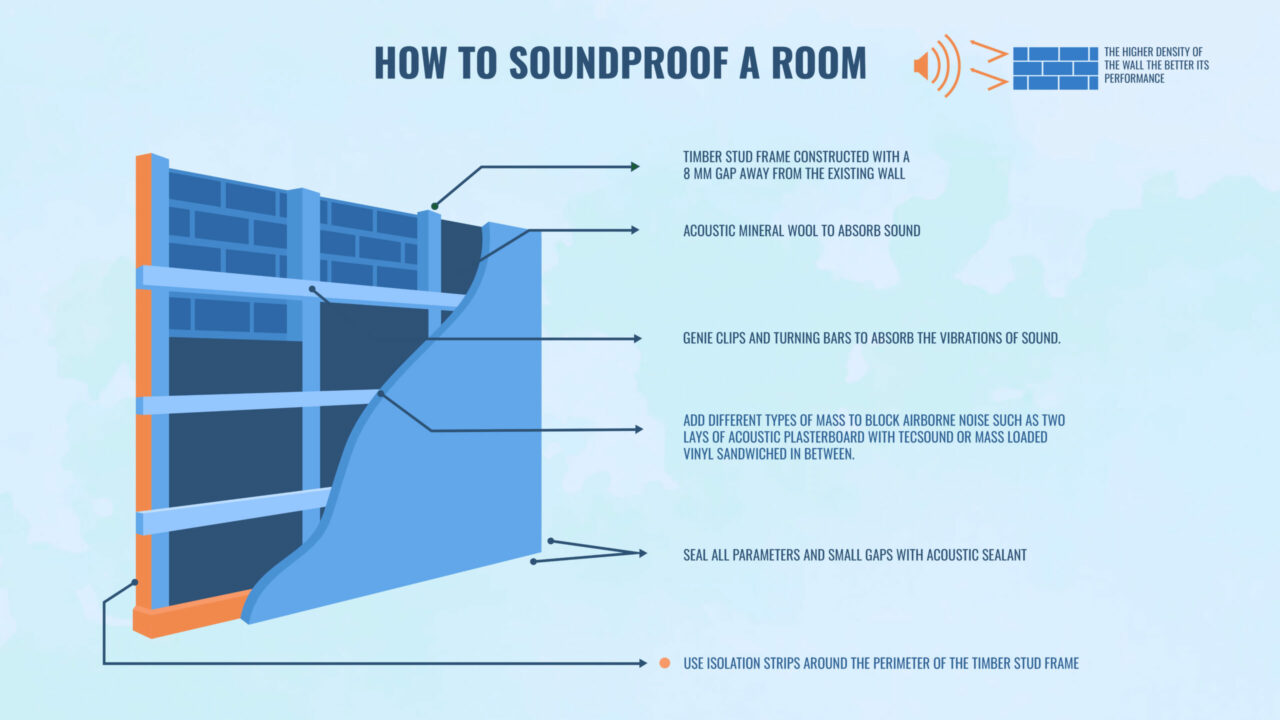
Minimizing sound in a room means incorporating different methods and combining them together. Each part of the room calls for its own remedy!
The existing wall, floors, doors, and your music room have different ways of soundproofing, and we will discuss each one below:
Soundproofing Walls and Existing Walls
First in line with soundproofing are the walls. Soundproofing your walls gives you peace, productivity, and safety.
Here are the different ways to achieve this:
Use Thick Curtains
Thick curtains are excellent sound-absorbing materials, and placing them on your walls can yield favorable sound reduction results!
Yet, the ability to absorb sound efficiently depends on the distance of the curtains from the entire wall:
- On one hand, the closer the heavy curtains are to the wall, the higher the sound absorption of high-frequency sound waves.
- On the other hand, with increasing distance, there can still be high sound absorption but only low-frequency sound waves.
With these said, regardless of distance, the ability to minimize sound reflection can be efficiently done using heavy curtains.
Use Acoustic panels
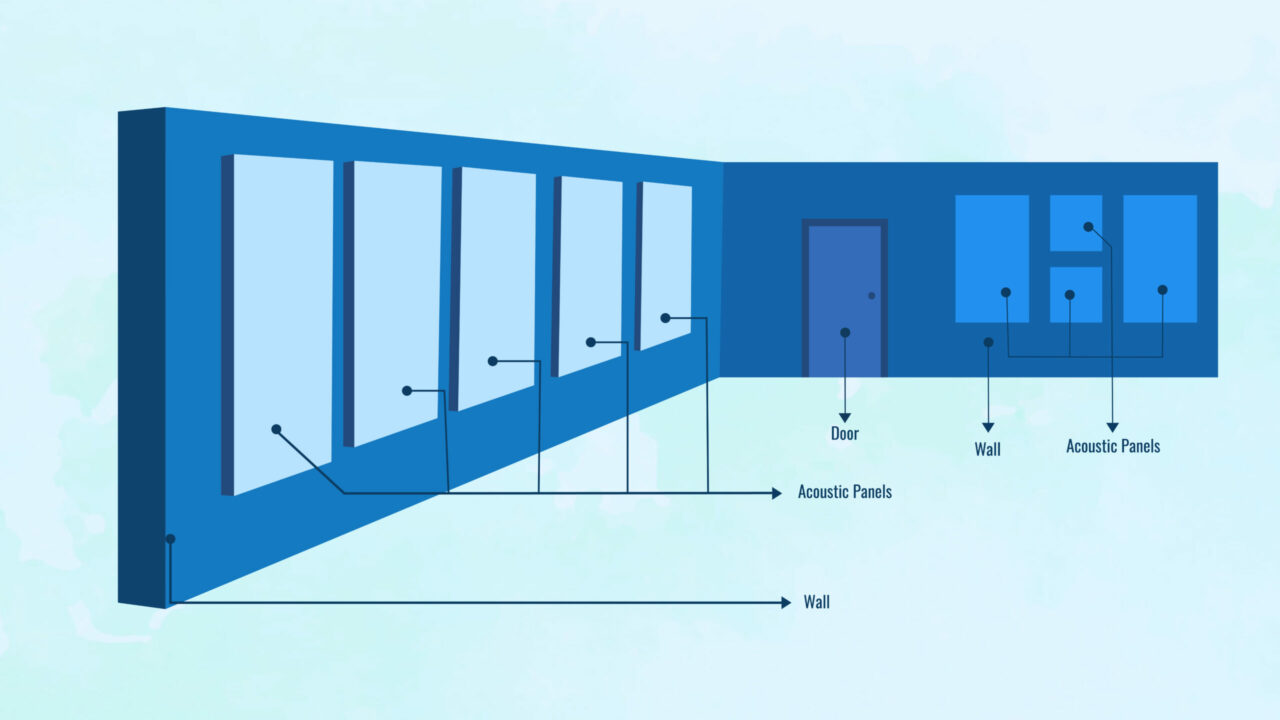
Aside from heavy curtains absorbing sound, you can also soundproof a room by hanging acoustic panels.
These panels are considered experts in echo and sound reduction, mainly because they are characterized to be porous.
FUN FACT
The studied diameter to efficiently absorb sound are those acoustic panels with 1.41 mm-sized holes.
Soundproofing Floors
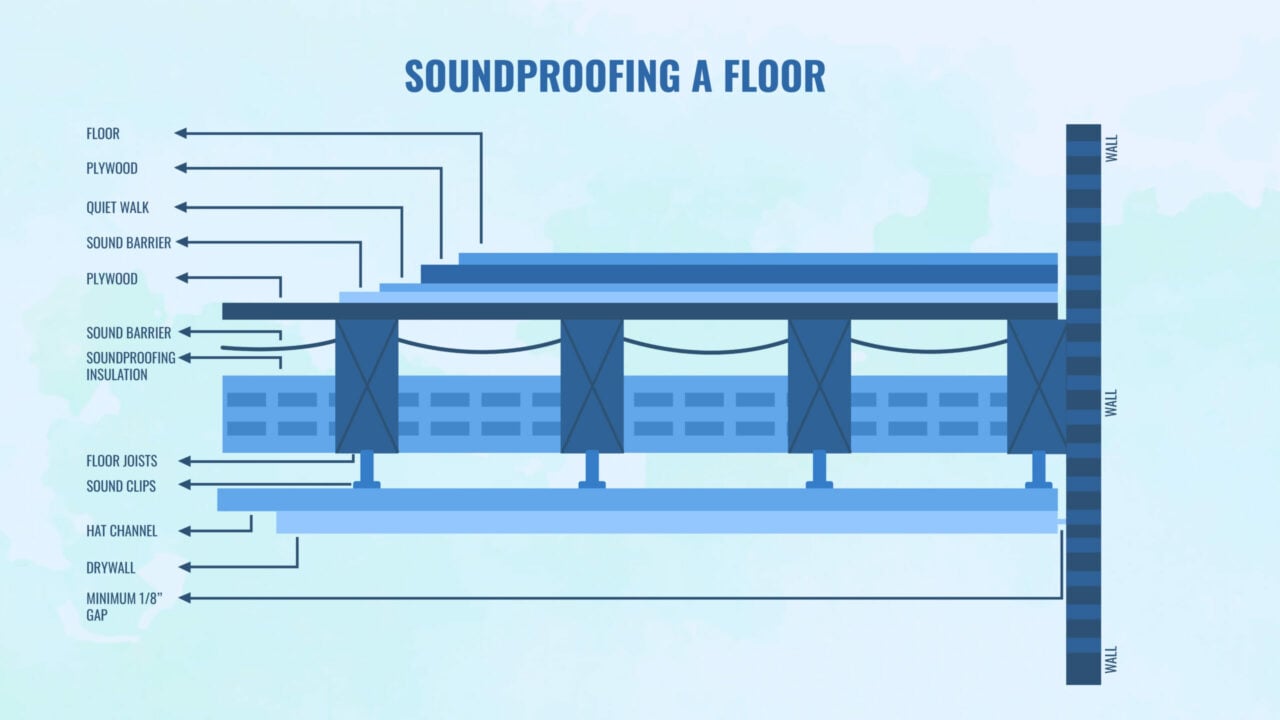
Next on the list of the parts of your room that you need to soundproof are the floors.
This is especially important to deal with if you live in a rented apartment or own a recording studio on the second floor.
To block any sound coming from below, here’s how to soundproof a room’s floor:
Add Area Rugs
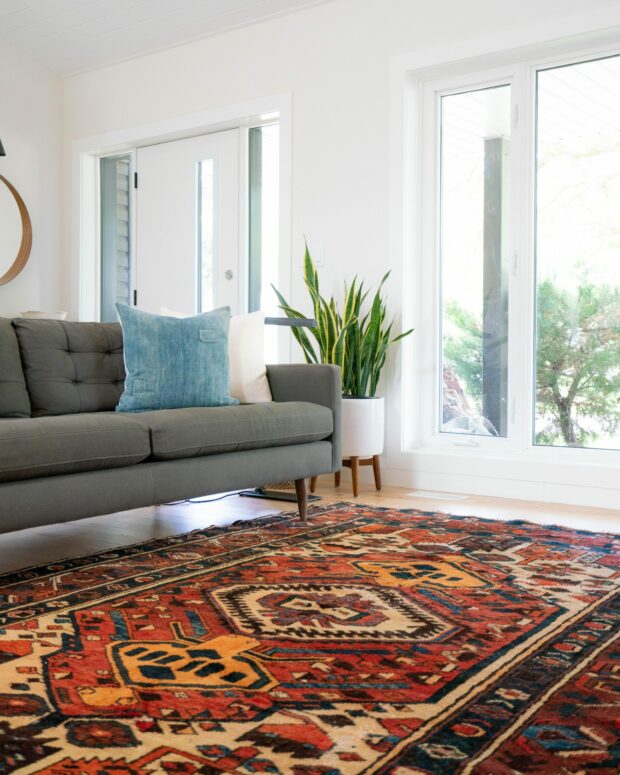
Hard surfaces, such as floors, are prone to sound reflection. To balance this out, turn them into soft surfaces!
This is how a thick rug can help soundproof a room for acoustic treatment. This method is also excellent to use for those who need to soundproof their hardwood floors!
These are the impacts of a thick rug to soundproof a room:
- Absorb sound
- Sound blocking
- Noise reduction, particularly in sound transmission
You can also add a pad, from 0.3 inches to 0.5 inches, under the rugs to make soundproofing floors more successful. Make sure the pads have one or all of these materials and features:
- Memory foam
- Felt-made
- Rubber
While some of these pads may not hold anti-slip properties, they can surely block unwanted sound.
Nevertheless, since these are under the rugs, it will not matter that much, especially when your rugs are already anti-slip anyway.
Add Upholstered Furniture
Upholstered furniture can also be a practical addition if you want your room soundproof, as they dampen noise.
To soundproof a room using upholstered chairs, sofas, and bookcases (among others), make sure to place them near the sound source.
With this, the sound waves will have limited entrance, as the furniture can filter them out.
Not just that, upholstered pieces of furniture bear soft and open-celled materials which help bring and lock in the noise, preventing noise from bouncing back.
Here are some of the upholstered materials in furniture that you can use to get the soundproofing effect you’re looking for:
- Artificial leather
- Chenille
- Corduroy
- Hessian fabric or textile
- Lightweight polyester
- Microfiber
- Muslin
- Natural rubber or latex
- Suede
- Velvet
PRO TIP
With an expert’s help, you can also try lamination on your flooring, as this is also a decent way to soundproof a room by just a bit.
Soundproofing Doors
Doors do not just welcome people; they also let noise in, particularly through gaps in door jambs.
To prevent sound from pestering your productivity, here is what you must do:
Use a Door Gasket and a Door Sweep
Door gaskets secure the lining separating the main door from the jambs and headers, which can be rubber, silicone, and aluminum.
On the other end, to soundproof a room, a door sweep is needed along with the gasket. A door sweep is in-charge of sealing the gap between the bottom end of the door and the floor.
Using these two hand-in-hand can help reduce noise coming through your apartment, condominium, or bedroom door.
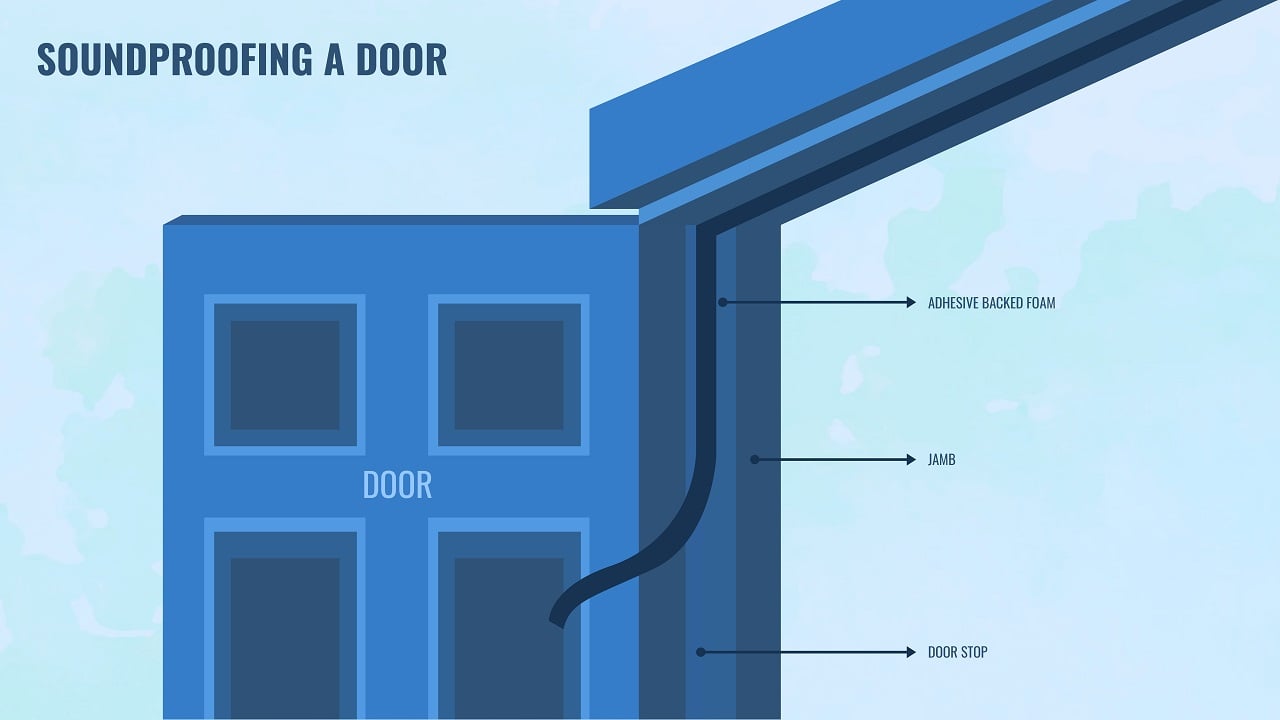
Use Acoustic Foam
Acoustic foam is a helpful tool to reduce unwanted sounds that enter your space or room.
This is different from the regular foam you usually see on the market because this has higher pores per inch (PPI).
With higher PPI comes a good number of pores that can limit more sound from entering the premises of your recording studios or working areas.
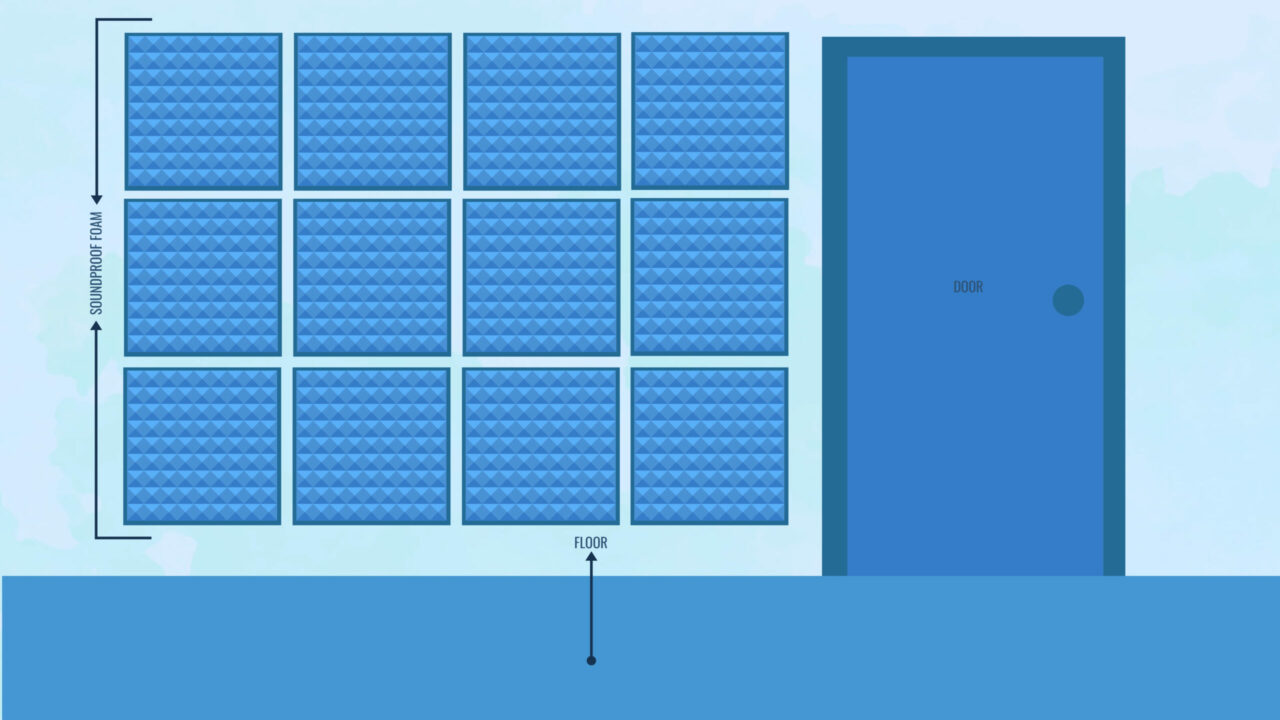
Use a Solid-Core Bedroom Door
A solid-core door is an excellent addition to soundproof a room!
The interior of this door type is composed of wood and synthetic materials, which gives it better insulation.
But note that these doors may cost more than a hollow core door since they use more expensive materials than the latter, which typically uses thin honeycomb cardboard.
Soundproofing a Rented Apartment
Sometimes, downstairs neighbors can be noisy in rented apartments to the point of toxicity.
Yet, you may hesitate to soundproof the apartment because the process can be expensive, and your lease may end soon anyway.
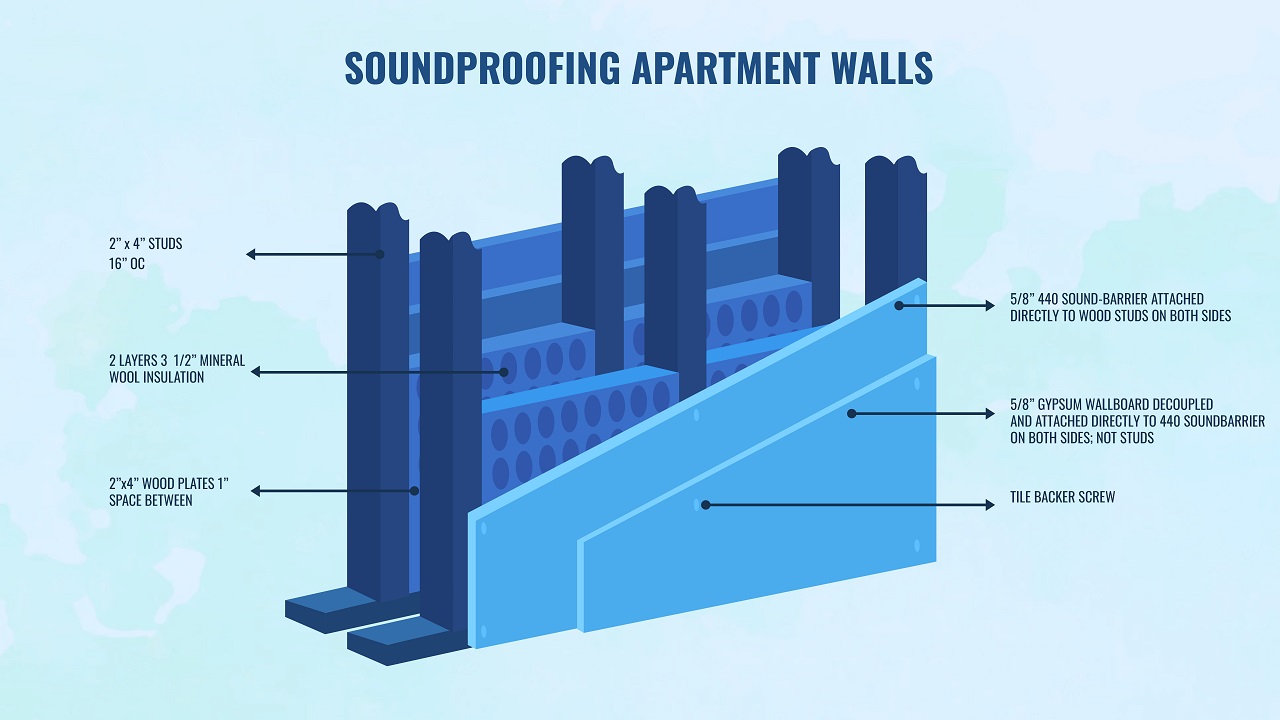
Don’t fret! We have here the steps on how to soundproof an apartment room with cost-effective solutions:
- First, consult your landlord and revisit your contract to see if you can apply changes to the rented apartment. Make it clear to the landlord whether or not you can have permanent or temporary changes.
- Next, if the contract stipulates that you can, you can now identify where the noise usually comes from and address it first.
- If the noise comes from the window, seal your windows through weatherstripping, and cover them with dense soundproof curtains.
- When an unnecessary sound leaks from the door, a door sweep, gasket, and acoustic foams can help. You can also ask your landlord to change hollow wood doors into solid-core ones.
- If the incoming sound is from your downstairs, upstairs, or next-door neighbors, ensure that your walls have acoustic panels, your floors have upholstered furniture and thick rugs, and you have an acoustic drop ceiling to absorb and prevent the sound bounce.
BOTTOM LINE
Focus on the walls, ceilings, and flooring, just like any other room! You can use any of the soundproofing methods we mention in this guide for your apartment.
Soundproofing Your Music Room
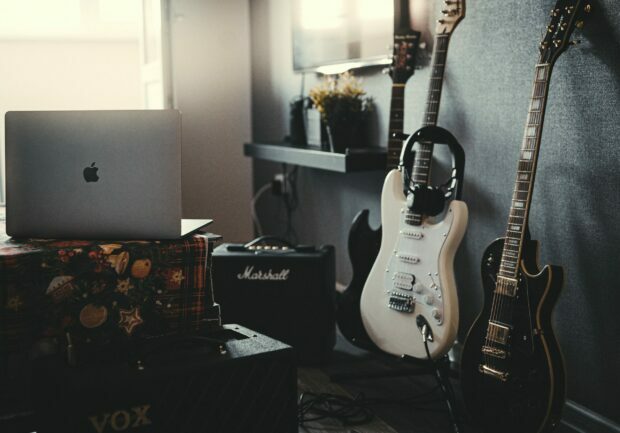
If you’re planning on building music rooms and recording studios, you need to block noise to play music and record without unsolicited interference.
Whether you are soundproofing your garage or your extra bedroom for your music studio, here are the things you should follow:
- Add mass to stop noise by using drywall sheets, drywall screws, or just adding another layer of soundproofing panels to the existing drywall
- Seal gaps in the doors using door sweeps and on windows, acoustical caulk, acoustical sealant, or adhesive
- Change or modify your doors if it’s the only thing left needed for sound blocking. Remember to choose something other than a hollow core door, even if they are cheaper.
PRO TIP
Use a knife to seal properly without excess sealant from each angle.
Soundproofing Alternatives
When soundproof materials become expensive, alternatives will surely come to your rescue.
Here are alternative soundproofing techniques you can consider doing:
Sound Machines
On the question of how to soundproof a room, sound machines come to play as they can filter unwanted noise.
Yet, they are only temporary solutions as they can only partially make your room soundproof.
Air Purifiers
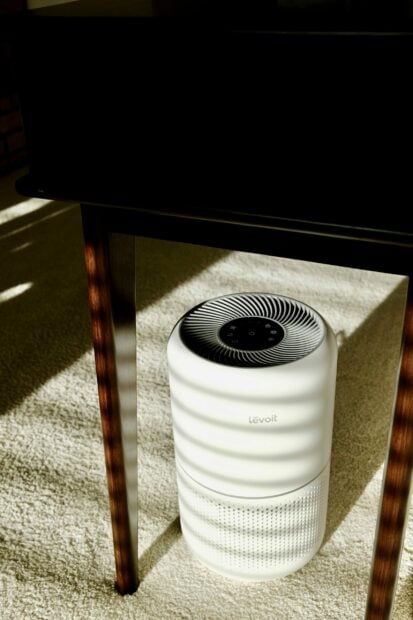
White noise machines (a type of sound machine) mimic hushing sounds to help children and adults sleep at night. Even though they can block incoming or disruptive noises, they still produce sounds.
Air purifiers are devices used to filter indoor air, allowing individuals to breathe clean air and help reduce the chances of inhaling airborne diseases and harmful chemicals.
Although air purifiers cannot entirely block sound, they can help dampen noise because they produce a unique sound at high speeds.
Nonetheless, there have been air purifiers on the market that are of high quality and perform quietly.
Electric Fans
Standard electric fans are great alternatives to block unwanted external noise as they give off a subtle background sound.
It works similarly in terms of soundproofing with the air purifier; it is just that the latter has another purpose which is to purify the air.
Why Should You Soundproof Your Entire Room?
Soundproofing your room will only lead to good things, like being able to focus on work, studies, and your personal life, without the distractions of noise pollution.
Let’s dive deeper and understand WHY you should soundproof a room as soon as possible:
1. Prevents Noise Pollution-Induced Health Problems
Noise pollution is the domination of unwanted sounds in the environment.
Although it has been relatively regular in busy streets, a study has found that this type of pollution can cause health problems.
Here are some of the health matters that can arise from noise-polluted surroundings:
- Hearing impairment or noise-induced hearing loss (NIHL)
- Ischemic heart disease
- Creates negative social behaviors
- Hypertension
- Compromises cognition
- Irregular sleeping pattern
- Impedes verbal communication skills
- Mental health problems
The impact noise has is more than just your hearing; its impact also ripples through other parts of your body!
With this, it is recommended to consider soundproofing a room.
Not just that, it is better to soundproof a room by buying the materials at the start of the construction process and before you move in (if you are renting).
2. Helps in Productivity
Without unnecessary noise, you can surely do important tasks with ease without having to worry about someone else’s problem that you can hear through your walls.
If you live in a city with busy streets, you also won’t have to worry and be annoyed with raging drivers manically beeping on the streets.
Research shows that vehicular noises create difficulties in attention and motivation among individuals, specifically school children.
True enough, another study emphasizes that noise can adversely affect memory, learning, and other cognitive functions.
When you soundproof a room, these effects can be prevented or stopped as long as you have the suitable materials and if you have identified the source of different noises.
3. Promotes Privacy
Without soundproofing floors, doors, walls, and windows, you cannot shout at the top of your lungs without your neighbors hearing you; the same goes the other way around.
This scenario tells us that talking about confidential matters may not be possible when the next-door occupants can hear you. So, this is where soundproofing enters the conversation.
With soundproofing, you get a sense of individuality and security as you are assured that whatever comes out of your mouth will not travel through the walls of the other room.
In relation to this, research in interior design shows that employees prefer to work and are more fruitful when architectural privacy and soundproofing have been considered in their office design.
4. Improves Sleep
In a soundproofed room, your chances of having a good sleep quality increase because of noise reduction.
According to a study, excellent room acoustics immerse an individual in a deep sleep and lessen the probability of waking up in the middle of the night.
Moreover, it is essential to remember what another research pointed out: outside noise can often cause disturbances in your sleeping pattern, which negatively alters your productivity during the day, and your overall quality of life.
5. Reduce Stress
Your stress levels can decrease if you can peacefully do your workload without hearing your neighbor’s rants, the hustling and bustling of vehicles, and other noise pollutants.
Researchers in a study found that noisy surroundings can significantly contribute to psychological stress, which translates to poor life quality.
With a proficiently soundproof room, you can get better sleep and be more productive in your work, studies, and everyday chores, which can lessen the stress and annoyance you feel when noise is present.
List of the Best Soundproofing Materials
A how-to soundproof a room article will only be complete with a list of the best soundproofing materials.
Although we mentioned some in the previous sections, we still want to give you a little more convenience by listing some other materials down below:
Acoustic Foam Tiles
Acoustic foams are polyurethane and open-celled, meaning more than 50% of their holes or cells are open.
Moreover, these are usually produced in the form of tiles with different shapes (i.e., triangles, pyramids, grids, wedges, etc.).
These characteristics of the acoustic foam tiles enable them to absorb noise and minimize the possibility of sound reflecting on surfaces.

These acoustic foam tiles are usually applied on walls, floors, and ceilings where more sound tends to enter.
PRO TIP
On top of foam tiles, you can utilize an acoustic drop ceiling to lessen your sound’s reverberation and minimize the incoming sound from your upstairs neighbor. However, this can lead to added costs.
Acoustic Panels
Acoustic panels help to soundproof walls, ceilings, and even doors. They absorb noise and turn them into heat energy.
Moreover, acoustic panels come in different types, bearing different materials, such as:
- Fiberglass
- Perforated wood
- Vegetable-based fabric or textile
- Polyester
More importantly, as these acoustic panels are visible and their placement affects the visual aesthetics of your room, these acoustic panels also come in different shapes and styles:
- Rectangular panels
- Wedge or wall studs
- Hexagonal acoustic panels
- Square panels with horizontal and vertical lines
Another interesting aspect of acoustic panels is that they vary in size, determining how much you need to make your room soundproof.
It is also possible to choose acoustic panels based on whether your room has enough space. Here are some of the common size choices for panels:
- 2400 x 1200 cm
- 2400 x 600 cm
- 2400 x 300 cm
- 1200 x 600 cm
- 600 x 600 cm
Full Sound Booth
If you want to record sound without noise disturbances coming into you like an avalanche, consider using a full sound booth instead of soundproofing your entire wall and other parts of the room.
In creating a full sound booth, here are the things you must have:
- Acoustic panels
- High-quality indoor wood frame
- Wood doors
- Drywall screws
- Drywall sheets
- Acoustical sealant
- Door sweep
- Acoustic or foam tile
FUN FACT
Drywall screws have springs that complement several soundproofing techniques when used as a binder or screw for drywalls, as it helps absorb sound.
A full sound booth is an effective soundproofing technique that limits sound bouncing and improves your recording acoustics without having to soundproof the entire room.
With a soundproof booth, you can choose to make a corner of a room fully soundproof without having to incorporate every soundproofing material possible.
With this, you can still have fresh air inside your room right after you open your sound booth door.
Sound-Absorbing Rugs
Soundproofing floors can be easy with sound-absorbing rugs, which integrate the following components:
- Bamboo fiber
- Cotton
- Wool
- Coconut fiber
These rugs need to be thick, preferably 10 mm to 18 mm, to absorb or block the sound coming, particularly from the floor.
Cotton Batts
Cotton batts are a great addition to the wide variation of soundproofing ideas, as these layers of cotton create a porous composition that absorbs sound.
These batts are strategically placed on walls, ceilings, and floors.
When you place them right where the sound enters, they help limit the sound reverberation; this is how the cotton batts stop the noise.
Moreover, cotton batts made from recycled cotton materials can be the better alternative if you do not have the budget for fiberglass insulation, which could cost you an average of $300 to $600.
Soundproof Blankets
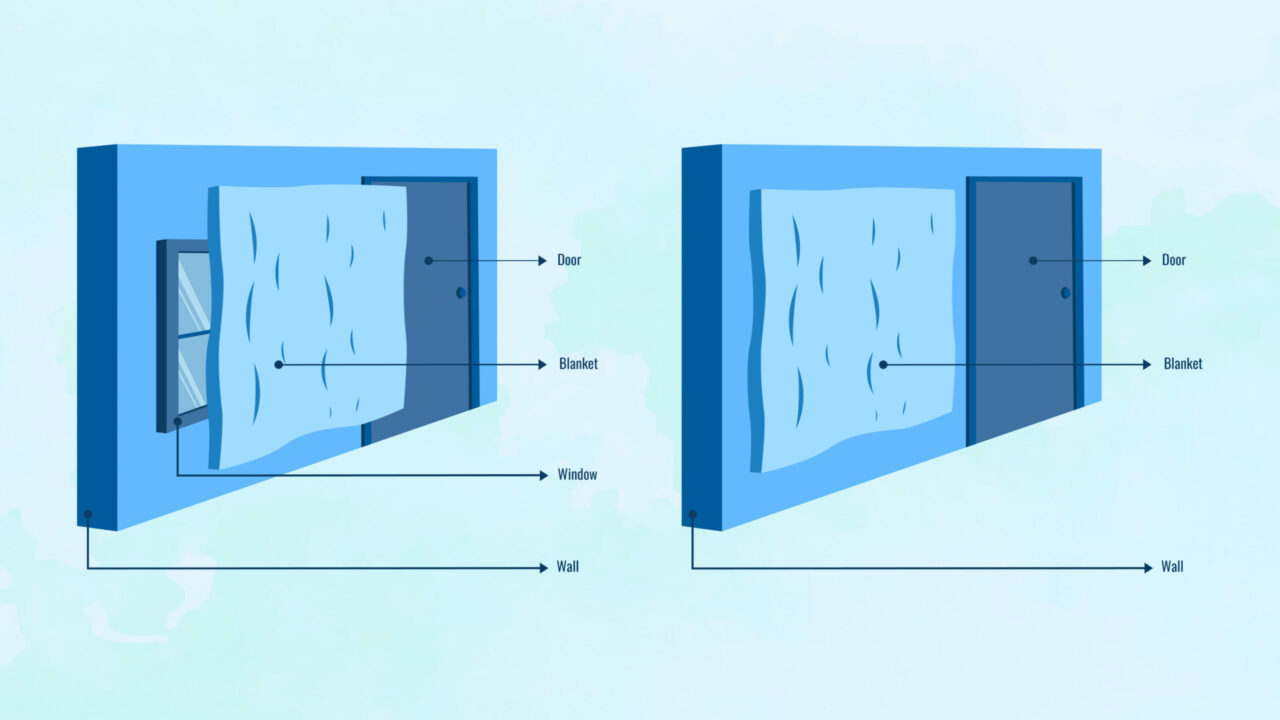
A blanket can be your soundproofing buddy, especially those made from these materials:
- Polyester
- Fiberglass insulation
- Recycled cotton
- Recycled quilted fiber
- Cotton
- Mass loaded vinyl
- Nylon
Although these blankets are probably included in the cheaper-options list, you may need some help if you use these in soundproofing walls, as premium sound-blocking blankets can have a weight range of 7 lbs to 90 lbs.
Soundproofing Do’s and Don’ts
Now that you know how to soundproof a room, including the materials needed, some essential tips and tricks can efficiently guide your soundproofing journey.
To help you smoothly transition to a soundproof room, here are some do’s and don’ts to seal the deal:
Soundproofing Do’s
- Do consider the regulations imposed – Before starting any improvements or changes on your room or apartment, make sure to consult your building code or your landlord. With this move, you get to soundproof a room securely without having problems with rules and regulations.
- Do try to soundproof a room depending on the nature of your work – To maximize materials, and choose the befitting ones for your room, try to make it parallel with what level of sound reduction your work requires. This is not just effective in creating a soundproof room, but it will also be cost-efficient.
- Do consider your room space – Before going on a soundproof-material shopping spree, get a professional (or do it yourself) to measure your room space precisely. The correct measurement will translate to how much soundproofing equipment you need (e.g., how many pieces of drywall screws you need).
- Do think about the appropriate arrangement of furnishings – By planning the interior design (e.g., placing the chair on the right side corner against the existing drywall), you will have an easier time identifying lacking soundproofing materials.
- Do create a dead air space – A dead vent (preferably furnished on your soundproof walls) will help hot air move out from your room and let the fresh air inside. Also, this vent has a system that minimizes and creates the first-level barrier for sound. It will also lessen the reverberation or bouncing back of the sound.
- Do choose the best soundproofing material – Choosing the best soundproofing equipment means saving time, effort, and resources, as these high-quality materials can immediately help you soundproof a room. Sometimes, these materials entail high initial costs, but you are assured of durability and efficiency. Nonetheless, it does not always need to be expensive because there are affordable alternatives right in front of you, such as thick rugs, curtains, and pre-existing furniture.
- Do test recordings before finalizing the soundproof room – Test recordings before finalizing your room! This is vital to assess the lacking elements to complete a soundproof room ready for any sound-related workload. If you do not want to go through recordings, you can always check your room’s acoustics by means of clapping. As you clap, listen to the echo. If there are none, then you are good to go.
- Do use soft furnishings – Soft furnishings absorb sound better because of their porous nature, letting sound in without reverberating.
Soundproofing Don’ts
- Do not over-soundproof a room – Over-soundproofing means getting the life out of your room completely. Although this can block out any noise, this can also create unnatural acoustics. Also, this will not help you have premium-quality sound recordings. Rather, an overdone room will strip off your recordings’ clarity and focus.
- Do not damage your walls if not really needed – In soundproofing walls, there are many alternatives that will not require you to dismantle them immediately. The acoustic treatment for walls includes the use of acoustic panels (which can also be aesthetic if you choose art-inspired and patterned ones), hanging of duvet covers or curtains, and even the placement of upholstered pieces of furniture against the walls.
- Do not neglect the rules – Remember, if you alter a room and it goes contrary to the stipulation, you may pay for damages. Worst-case scenario, you may be forced by law or contracts to remove what you have installed. This means all your hard work and money will go to waste.
- Do not forget the ventilation – A well-ventilated room is important to create a better soundproof environment. Of course, choose equipment that does not have irritating noise when turned on. Sound-reducing ventilation ducts are also available on the market that are beneficial for your cause of soundproofing your room. Yet, the best option would be to consult professionals to help you with the layout and actualization of efficient ventilation plans.
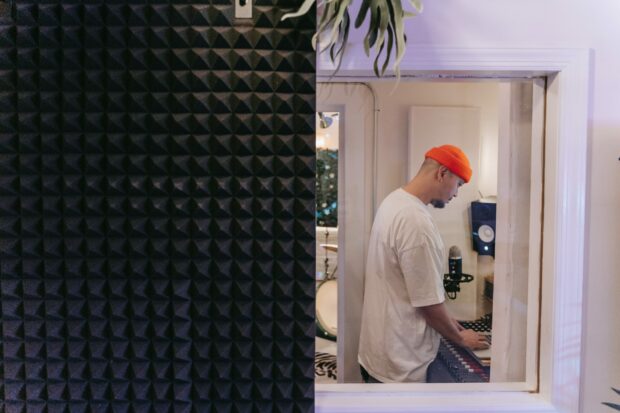
Frequently Asked Questions
After everything we’ve gone through in the previous sections, you might still have some questions in mind you want to clear out.
Here are some of the most frequently asked questions regarding all the things about how to soundproof a room:
Can You Completely Make a Room Soundproof?
You can completely make your room soundproof using different materials such as curtains, acoustic panels, rugs, carpets, mats, furniture, acoustic foam, door sweepers and gaskets, solid-core doors, sound machines, air purifiers, and electric fans.
However, bear in mind not to overdo soundproofing. An overdone soundproofed room can lessen the quality of your sound rather than elevate it, as the sounds will lose their natural characteristic.
Even though your goal is to make your sound clear and crisp, when you overdo the room’s soundproofing, it creates muffled sounds.
What Are the Cheapest Ways to Soundproof a Room?
The cheapest ways to soundproof a room include the use of the materials listed above and the following ones:
Thick blankets
Door stopper
Upholstered pieces of furniture
Soft furnishings (e.g., cotton)
Sound-dampening curtain and rug
Acoustic caulk
Window film
How Can You Soundproof a Room Without Destroying Existing Walls?
You can always add acoustic panels and heavy yet soft-clothed curtains to soundproof a room without destroying existing walls.
You can also ensure that your doors and windows do not have unnecessary gaps by putting on some window inserts and door sweeps.
Another important thing to consider is adding more drywall to the existing drywall. In addition, put some mass-loaded vinyl, an affordable and effective alternative.
What’s the Best Soundproofing Material to Block Sound and Unwanted Noise?
The best soundproofing techniques include the use of soft furnishing and open-cell insulation materials, such as:
Fiberglass insulation
Plush couches and mattresses
Blow-in cellulose insulation
Acoustic caulk
Conclusion
All the information mentioned in this article can surely help beginners figure out how to soundproof a room the RIGHT way.
Now that you are aware of what things to use, how to place the materials, and all the important do’s and don’ts, nothing is stopping you from getting the soundproof room you’ve always wanted to improve your work and living conditions!
Just remember that a soundproof room can give you privileges as it can prevent noise-induced health problems, boost productivity, favors privacy, and improve the quality of your sleep.
So, what are you waiting for?
Identify where the sound comes from and what your room needs, and start your soundproofing project and reap the benefits!


